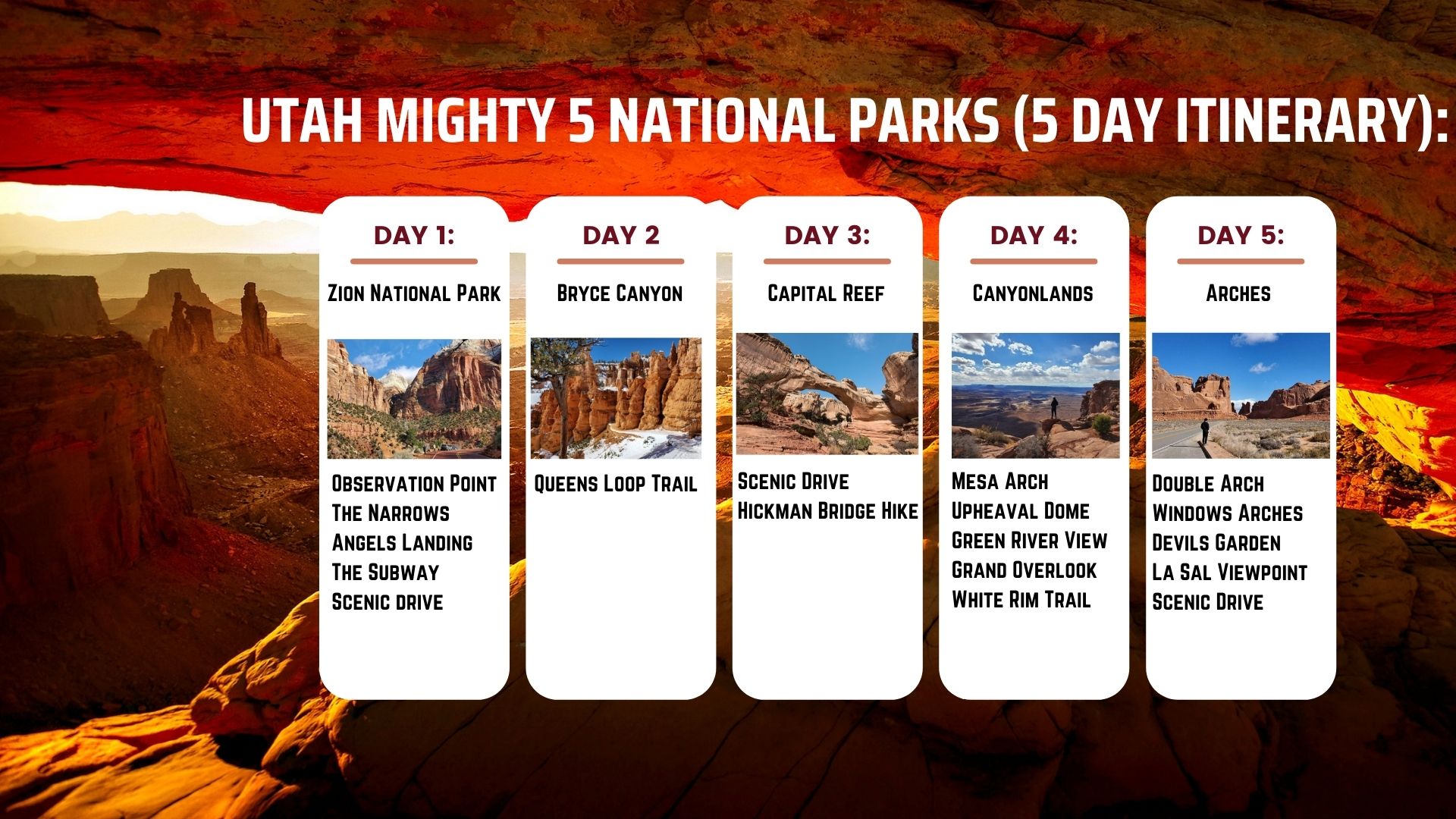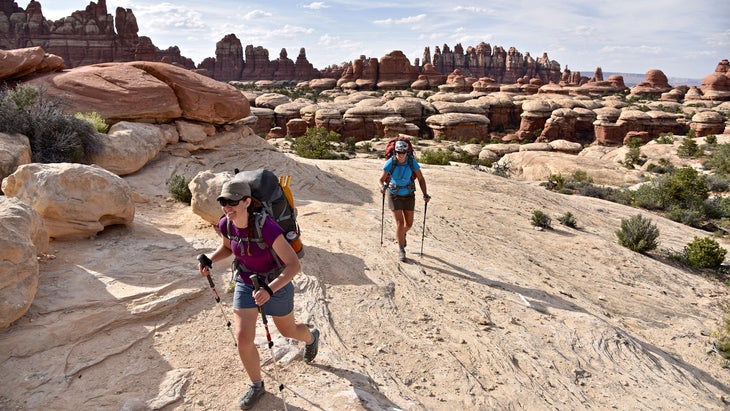Utah National Parks Road Trip, 5 Days
Utah national parks road trip 5 days – Utah National Parks Road Trip: 5 Days – Imagine yourself traversing the breathtaking landscapes of Utah, witnessing the iconic arches of Arches National Park, the vast canyons of Canyonlands, the mesmerizing hoodoos of Bryce Canyon, and the majestic Virgin River carving its way through Zion. This five-day itinerary promises an unforgettable adventure, meticulously planned to maximize your time and experience the best of Utah’s natural wonders.
Get ready for stunning vistas, challenging hikes, and memories that will last a lifetime.
This detailed guide covers everything from planning your route and packing essentials to navigating the parks and discovering hidden gems. We’ll explore the best time to visit, considering weather and crowds, and suggest various accommodation options to suit your budget. We’ll also delve into the unique geological formations, highlighting must-see viewpoints and recommending trails suitable for different fitness levels.
Beyond the parks, we’ll uncover some lesser-known attractions, ensuring a well-rounded Utah experience.
Planning Your 5-Day Utah National Parks Road Trip

A five-day Utah National Parks road trip requires careful planning to maximize your time and experience. This itinerary balances travel time with ample exploration, focusing on Arches, Canyonlands, Bryce Canyon, and Zion National Parks. Remember that travel times between parks can vary depending on traffic and road conditions.
Detailed Five-Day Itinerary
This itinerary assumes you’ll begin and end your trip in Moab, a central location for accessing several parks. Adjust based on your starting point.
- Day 1: Arches National Park: Arrive in Moab, check into your accommodation, and spend the afternoon exploring Arches. Focus on iconic arches like Delicate Arch and Landscape Arch.
- Day 2: Canyonlands National Park (Island in the Sky): Drive to Canyonlands’ Island in the Sky district (approx. 1-hour drive). Enjoy scenic drives and short hikes, taking in panoramic views.
- Day 3: Travel to Bryce Canyon National Park: A long driving day (approx. 4-5 hours). Check into your Bryce Canyon accommodation and enjoy a sunset view over the amphitheater.
- Day 4: Bryce Canyon National Park & Travel towards Zion: Explore Bryce Canyon’s trails, focusing on Navajo Loop and Queen’s Garden Trail. Drive towards Springdale, near Zion National Park (approx. 1.5-2 hour drive) and check into your accommodation.
- Day 5: Zion National Park: Explore Zion Canyon Scenic Drive (reservations may be required for shuttle access) and choose a hike based on your fitness level. Depart from Springdale in the late afternoon.
Essential Packing List
Packing efficiently is key for a road trip. This list categorizes essentials for easier packing.
- Clothing: Layers are essential for varying temperatures, including hiking boots, comfortable walking shoes, moisture-wicking shirts, warm layers, rain jacket, hat, sunglasses.
- Gear: Backpack (daypack), water bottles or hydration reservoir, binoculars, camera and extra batteries, headlamp or flashlight, hiking poles (optional but recommended).
- Supplies: Sunscreen (high SPF), insect repellent, first-aid kit, medications, snacks, reusable water bottle, maps (download offline maps!), park pass.
Best Time to Visit
Spring (April-May) and Fall (September-October) offer pleasant temperatures and fewer crowds than summer. Summer (June-August) can be extremely hot, especially in the canyons, while winter (November-March) brings snow and potential road closures, particularly at higher elevations.
Exploring Arches National Park
Arches National Park boasts over 2,000 natural sandstone arches, sculpted by wind and water erosion over millions of years. The park’s landscape is characterized by dramatic rock formations, towering monoliths, and vibrant colors.
Iconic Landscapes and Geological Formations
The park’s most famous features include Delicate Arch, Landscape Arch, Balanced Rock, and Double Arch. These formations showcase the unique geological processes that have shaped the park over millennia. The sandstone itself, predominantly Entrada Sandstone, is easily eroded, leading to the formation of arches, fins, and other unique features. The park’s red and orange hues are due to the iron oxide within the sandstone.
Popular Hiking Trails
Arches offers trails for all skill levels. Always check trail conditions before embarking on a hike.
- Delicate Arch Trail (3 miles, moderate): A challenging but rewarding hike to the iconic Delicate Arch. Allow 3-4 hours.
- Landscape Arch Trail (1.9 miles, easy): A relatively easy walk to the world’s longest natural sandstone arch. Allow 1-2 hours.
- Balanced Rock Trail (0.3 miles, easy): A short, paved loop trail to the impressive Balanced Rock. Allow 30 minutes.
Best Viewpoints for Photography
The best time for photography is during the golden hour (sunrise and sunset) when the low-angle sunlight casts long shadows and illuminates the arches in a warm, dramatic light. Consider these locations for stunning shots: Delicate Arch viewpoint, Balanced Rock viewpoint, and the Windows Section.
Discovering Canyonlands National Park: Utah National Parks Road Trip 5 Days
Canyonlands National Park is a vast expanse of canyons, mesas, and buttes, divided into three districts: Island in the Sky, Needles, and The Maze. This itinerary focuses on Island in the Sky, easily accessible from Moab.
Island in the Sky vs. Needles Districts
Island in the Sky is characterized by its high elevation viewpoints offering panoramic vistas of the Colorado River and surrounding canyons. The Needles district, further south, is more remote and features intricate canyons, spires, and challenging hikes.
Scenic Drive Through Canyonlands
The Island in the Sky district’s main road offers numerous viewpoints. Grand View Point offers breathtaking views of the Colorado River, while Mesa Arch provides stunning sunrise views (arrive early!). White Rim Road (high-clearance vehicle required) offers a more adventurous off-road experience.
One-Day Itinerary for Canyonlands (Island in the Sky)

- Morning: Arrive early and hike to Mesa Arch for sunrise.
- Mid-morning: Drive to Grand View Point and enjoy the panoramic views.
- Afternoon: Explore short trails like the short walk to Upheaval Dome or the short paved trail to White Rim Overlook.
- Late Afternoon: Depart from the park.
Immersing Yourself in Bryce Canyon National Park
Bryce Canyon is renowned for its unique hoodoo formations, towering spires of rock created by erosion. These geological marvels create a breathtaking amphitheater of color and texture.
Unique Hoodoo Formations
The hoodoos are formed by the erosion of the Claron Formation, a layered sedimentary rock. Differential erosion, where softer layers erode faster than harder layers, creates these distinctive spires. The colors vary due to the minerals present in the rock.
Hiking Trails in Bryce Canyon
Bryce Canyon offers trails for various fitness levels.
- Navajo Loop and Queen’s Garden Trail (2.9 miles, moderate): A combined loop trail descending into the hoodoo amphitheater. Allow 1.5-2 hours.
- Rim Trail (various lengths, easy): A mostly paved trail along the rim, offering stunning viewpoints. Sections can be combined for longer hikes.
- Peek-a-Boo Loop Trail (5.5 miles, moderate): A longer loop trail with spectacular views of the hoodoos. Allow 2-3 hours.
Ranger Programs and Activities

Check the park’s website for ranger-led programs, including guided walks, talks, and astronomy programs. These provide deeper insights into the park’s geology, ecology, and history.
Experiencing Zion National Park
Zion Canyon, carved by the Virgin River, is a dramatic spectacle of towering cliffs, narrow canyons, and lush vegetation. The river plays a vital role in shaping the canyon’s landscape.
The Virgin River and Zion Canyon
The Virgin River has carved the main canyon over millions of years, creating the dramatic cliffs and narrow gorges that define Zion. The river’s power continues to shape the canyon’s landscape through erosion and deposition.
The Narrows vs. Angels Landing
The Narrows involves hiking through the Virgin River, often requiring wading (water shoes essential). Angels Landing is a strenuous hike to a summit with stunning views, requiring a permit and traversing chains in sections.
Alternative Activities in Zion
- Canyoneering: Explore slot canyons with guided tours.
- Horseback Riding: Enjoy guided horseback rides through the park.
- Rock Climbing: Zion is a world-renowned rock climbing destination.
Practical Considerations for Your Trip
Careful planning ensures a smooth and enjoyable trip. Advance preparation is essential, especially during peak season.
Accommodation Options
Options range from campgrounds within the parks (reservations highly recommended) to hotels and resorts in nearby towns like Moab and Springdale. Consider booking well in advance, especially during peak season.
Park Passes and Reservations
Purchase an “America the Beautiful” pass for access to all national parks. Reservations are often required for entry into some parks (like Zion Canyon Scenic Drive) and for certain campsites. Book these well in advance.
Staying Safe During Your Road Trip
- Carry plenty of water, especially during summer hikes.
- Inform someone of your hiking plans and expected return time.
- Be aware of changing weather conditions and potential hazards.
- Carry a first-aid kit and know basic first aid.
Beyond the Parks: Utah’s Hidden Gems
Utah offers more than just its famous national parks. Explore lesser-known attractions for a more diverse experience.
Lesser-Known Attractions
Consider visiting Goblin Valley State Park (near Arches), Dead Horse Point State Park (near Canyonlands), or exploring the backroads and scenic byways around the parks. These areas offer unique landscapes and opportunities for exploration.
Alternative Routes and Detours
Explore alternative routes between parks to discover hidden gems and scenic overlooks. Check road conditions before venturing off the main highways.
Wildlife Viewing Opportunities
Keep an eye out for wildlife such as deer, bighorn sheep, and various bird species. Respect wildlife by maintaining a safe distance and leaving no trace.
Creating Lasting Memories: Photography and Storytelling
Capture the beauty of Utah’s landscapes and document your journey for years to come.
Capturing Stunning Photographs, Utah national parks road trip 5 days
Utilize the golden hour (sunrise and sunset) for optimal lighting. Experiment with different compositions and perspectives to capture the essence of each location. Consider using a tripod for sharp images, especially in low-light conditions.
Documenting Your Journey
Keep a travel journal to record your experiences, thoughts, and observations. Consider creating a photo album or video montage to share your adventure with others. Use social media to document your trip.
Creating a Compelling Narrative
Share your stories and photos with others. Focus on your personal experiences, the challenges you overcame, and the moments that resonated with you the most. Your unique perspective will make your story compelling.
After five days immersed in the raw beauty of Utah’s national parks, you’ll return home with a heart full of awe and a camera roll brimming with stunning photographs. This road trip is more than just a sightseeing adventure; it’s a journey of self-discovery, a testament to the power of nature, and an experience that will redefine your understanding of breathtaking landscapes.
Remember to cherish the memories made, the challenges overcome, and the sheer magnificence of the natural world that Utah so generously shares.
Share this content:

